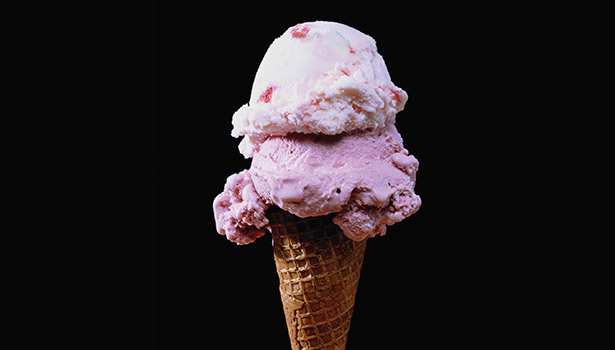How to achieve the best ice cream texture

Different frozen desserts raise different textural expectations. Soft-serve should be softer than hard-pack ice cream and gelato should be denser. But in general, consumers expect ice cream to have a rich, creamy texture, says Breanna Sellers of Gum Technology. Photo courtesy of Penford Food Ingredients

Air is a key ingredient of ice cream, says an expert at Penford Food Ingredients. Establishing an aerated microstructure plays a crucial role in the melt rate and overrun. Photo courtesy of Penford Food Ingredients

The ingredients used to make ice cream affect how the product feels on the tongue. “The amount of fat, protein, sugar — especially the kind of sugar — and the stabilizers and emulsifiers all contribute to the sensory experience,” says Ann Tigges, who works in Cargill’s technical services, dairy department. Photo courtesy of Cargill



Quiz a typical consumer on her Platonic ideal of ice cream bliss and she might respond with words like “chocolate-y,” “sundae” or even just “seconds, please.”
Ask Richard W. Hartel, however, and he’ll wax more elaborate, describing a treat that’s “smooth and creamy, not gummy or cloying,” “something with good melt properties” and one that “releases well-balanced flavors as the ice melts and leaves little mouth-coating behind.”
If it sounds like Hartel’s given this topic more thought than the typical consumer, it’s because he’s not the typical consumer. He’s a professor of food engineering at the University of Wisconsin-Madison, and principal advisor to its Frozen Dessert Center, where his research into the crystallization of ice, sugars and lipids — among other things — makes the world a better place for ice cream fans.
That’s no small feat considering that ice cream “is one of the most incredibly complex foods,” Hartel said. “It’s a foam with lots of small air bubbles, an emulsion containing numerous fat globules and a dispersion of ice crystals — all contained in a serum of unfrozen water with dissolved sugars, proteins and minerals from milk, and often stabilizers to help thicken the mix.”
Achieving and maintaining a smooth and creamy texture in such a system is an uphill battle under the best of circumstances. Now, with consumers’ quality standards rising in inverse proportion to their tolerance for “chemical-sounding” additives, ice cream makers face a harder task still. But by choosing the right texturizing ingredients and handling them strategically, it’s possible to craft an ice cream that lives up to everyone’s ideals.
Idealizing ice cream
Ice cream idealism, of course, is ultimately a matter of personal preference. As Donna Klockeman, senior principal food scientist for TIC Gums, White Marsh, Md., said, “Ice cream has a unique position because it’s often linked to fun, laughter, celebrations and joy associated with events like birthday parties, family gatherings and summer vacations.”
Setting such associations aside, enjoyment mainly boils down to sensory appeal, where texture plays a determining role. Though different frozen desserts raise different textural expectations — soft-serve should be softer than hard-pack ice cream; gelato, because of its lower aeration and fat content, should be denser — American consumers generally expect ice cream to have a rich, creamy texture, said Breanna Sellers, research & development laboratory technician for Gum Technology, Tucson, Ariz. (a business unit of Penford Food Ingredients, Centennial, Colo.).
And if ice cream processors do their part right, that’s what they get.
All in the mix
As Ann Tigges, technical services, dairy, Cargill, Minneapolis, pointed out, “The ingredients used to formulate ice cream make a great difference in how the product feels on the tongue. The amount of fat, protein, sugar — especially the kind of sugar — and the stabilizers and emulsifiers all contribute to the sensory experience.”
Fat, for example, contributes creamy texture. Differing fat sources — milk, cream, yogurt — display a variety of fat levels and fatty acid profiles, the combined effect of which plays out in the finished products’ mouthfeel. Fat levels also play out in the product’s standard of identity, as the Code of Federal Regulations specifies that an item calling itself ice cream shall contain not less than 10% milk fat.
“Sugar is another ingredient that can affect texture,” said Lorelie McRae, a Gum Technology food technologist. By helping segregate free water — yet another critical ice cream component — sugar “can act as an antifreeze agent that keeps the product from freezing entirely, resulting in a softer product,” McRae said.
And don’t forget air. Ice cream being, fundamentally, an aerated foam, “air is actually a key ingredient,” Sellers said. The establishment of that aerated microstructure, she explained, “plays a crucial role in the ice cream’s melt rate and overrun (the air whipped into the ice cream mix) and in reality affects every aspect of the ice cream’s texture and body.”
Underscoring the importance of processing to creating this effect, she added, “The final microstructure is strongly impacted by the viscosity of the mixture when freezing begins and by how the freezing process proceeds, which affects the rate of air incorporation.”
When defects attack
Play your cards right and all this processing and formulation unite in a physico-chemical structure that we recognize and appreciate as ice cream. But, said Sellers, “The goal is usually not only achieving a desired structure, but also stabilizing it.”
Why? Because while that structure is the foundation of what ice cream is, the structure of ice cream is generally very weak, said Maxime Saffon, application scientist at Penford Food Ingredients.And once it starts wobbling, textural defects creep in.
Perhaps the most common is graininess or iciness. As Tigges explained, “Consumers will open a container of ice cream and go back a few days later to find ice crystals invading their product. They can see the big crystals and feel them as crunchy and unpleasant particles when chewed.”
Tigges blames a phenomenon called heat shock for their emergence. “One theory is that a few large ice crystals form from the many smaller ones that melt and refreeze on a single nucleation point,” she explained. “This occurs when a frozen ice cream is slightly warmed or thawed and then refrozen to a hard texture again.”
The frost-free freezer, that marvel of the modern kitchen, probably holds the all-time record for generating heat shock. Or, as a colleague of Hartel’s is known to quip, “The frost-free home freezer is an ice cream destruction machine.”
Other sources of iciness and graininess include too slow a freezing process, poorly hydrated mix proteins and low stabilizer concentrations. A sandy texture, on the other hand, is mostly produced when the concentration of lactose — or dry solids — is too high or if the lactose crystals are too big, Saffon said. Suboptimal freezing conditions don’t help, either.
Gumminess can result from product drying out during storage, added Hartel. Greasiness can happen when an ice cream contains too much partially coalesced fat. Klockeman blames elastic and sticky textural defects on excessive stabilizer use, or simply the wrong combination of stabilizing agents.
All of which goes to show how important structural stabilization is to ice cream eating quality. And while workhorse ingredients like sodium carboxymethyl cellulose (CMC) and hydroxypropyl methylcellulose (HPMC) serve the industry in good stead by helping to reduce ice-crystal size, delay melting and greatly improve overrun, such stabilizers won’t fly in today’s environment of food bloggers and retailer ingredient “blacklists,” said Ana Maria Garavito Rojas, a Gum Technology food scientist.
Gumming up the works
Dairy manufacturers casting about for clean-label alternatives needn’t despair, as suppliers have stacked their benches with stabilizers that do just that without frightening away chemically averse consumers.
Granted, “’Clean’ is a completely subjective descriptor at this point,” said Tigges. Nevertheless, “There are ingredients that may be the right combination of functional and ‘clean.’”
Perhaps the granddaddy is the egg, and especially its yolk.
“Egg yolk contains proteins and natural phospholipids — like lecithin — that help emulsify the fat globules in ice cream,” Hartel said. “Egg proteins also help thicken the mix and take the place of added stabilizers.”
But the drawback, he said, is that egg proteins don’t work as effectively over the long term. And they can add significantly to formulation costs.
The next option, particularly when stabilization involves moisture management, is the current collection of gums and hydrocolloids, which not only thicken the ice cream mix, Hartel said, but “slow down the natural process of small ice crystals getting larger over time.”
And conveniently enough, many gums fall within the confines of the admittedly blurry “natural” category. As Garavito Rojas pointed out, “Most of the hydrocolloids used in this type of application are considered natural, as they’re sourced from plant material such as bean pods, seaweeds, tree sap and the like.”
But the world of gums is vast and complex, and some are more appropriate in certain applications than in others. So when advising ice cream, soft serve and frozen yogurt manufacturers on hydrocolloid choice, Garavito Rojas steers to them toward galactomannans, which she calls “excellent” at preventing ice-crystal growth. Guar, tara and locust bean gums bind excess water, with tara gum, in particular, exhibiting “outstanding heat-shock protection” while providing a silky mouthfeel that mimics creaminess, she said. “These attributes make it very attractive when freeze/thaw stability is of concern and when reduced-fat versions are formulated.”
Tigges singled out locust bean gum as “one of the premium gums for use in ice cream,” because its branching molecular structure traps and holds water, precluding heat shock and the formation of ice crystals. Locust bean gum typically appears in combination with guar gum and carrageenan but still texturizes efficiently on its own, “not only helping control free water in a system, but also contributing to mouthfeel.”
Other go-to hydrocolloids include xanthan gum, which confers elasticity and the characteristic “stringy texture” that gives soft serve its peaks, said Garavito Rojas, as well as carrageenan, which she claims imparts creaminess and a fatty sensation on the palate that would otherwise go missing in reduced-fat frozen dairy.
Yet gums aren’t the only game in town.
“Any of the hydrocolloids already mentioned in combination with citrus fiber would help promote aeration, retain moisture, reduce ice-crystal formation and prevent mix separation before churning,” Garavito Rojas said. Maltodextrins can bind formulation water to maintain the balance between what’s available for ice crystal formation and what isn’t. They also can decrease melting rates and improve microstructure expansion, Saffon said. However, he cautioned, “The use of maltodextrin needs to be controlled to prevent overexpansion.”
Inclusionary policies
With moisture-management tools like these, processors are on their way to maintaining texture in frozen dairy desserts. But how does the introduction of inclusions, variegates and coatings complicate the texturizing task? In short, Garavito Rojas said, the key is water control. Over the course of several freeze/thaw cycles, inclusions can cause syneresis, releasing water that’s liable to promote ice-crystal formation. Moreover, the liquid coming from inclusions can ‘bleed’ onto the ice cream, affecting its appearance,” he said.
Maya M. Warren, a food science graduate student in Hartel’s lab, said “Inclusion texture at frozen conditions has to be just right.”
For instance, a Skittle frozen along with an ice cream mix might break your teeth if you try biting into it. Similarly, “A chewy candy for ice cream needs to be much softer than its room-temperature counterpart — and that usually means there’s more water left.”
But because that water wants to equilibrate with that left unfrozen in the ice cream, “the water in the ice cream migrates into the candy, making inclusions like peppermint bites soft and mushy instead of crunchy as desired,” Warren said.
A similar dynamic occurs in chocolate. Chocolates designed for room-temperature consumption will be “hard as a rock in ice cream,” Warren said. “They have to be softened, usually by adding something like coconut oil.”
Other means of controlling inclusion texture include gums and hydrocolloids. Sodium alginate, pectin, carrageenan, blends of xanthan and locust bean gums or native cornstarch and tara gum all find frequent use, Garavito Rojas said, with the ultimate combination “depending on the final texture of the inclusion — more or less viscous, gel-type or otherwise.”
Let’s get physical
Ingredients like these that manage moisture form the backbone of the formulation-based approach to ice cream stabilization. But manufacturers can manipulate processing parameters to achieve a similar end — thus sidestepping any labeling issues that the use of “chemical” stabilizers might raise.
Consider how churning alone sets the stage for proper ice cream texture. As Garavito Rojas explained, “In frozen desserts like ice cream, the objective of churning is to freeze the ice cream mixture rapidly while simultaneously stirring it to avoid the formation of ice crystals.” But churning also aerates the ice cream, yielding the expected overrun and a smooth, creamy texture.
Processing is used to manage the fat portion of the microstructure, too. Hartel noted that by varying shear forces during freezing, manufacturers can increase the amount of partially coalesced fat in the mix.
“We don’t always have to change the emulsifier levels or types to change the structure of the fat globules,” he pointed out.
Even so, Tigges said that lecithin remains a “great” emulsifier, even in clean-label formulations, as it’s often sourced from sunflower, which is non-genetically modified and not considered an allergen. “And it’s useful in formulas where mono- and diglycerides might not be welcome on the label,” she said.
Lighten up
But fat doesn’t just benefit from the shear forces of ice cream production; it actively participates in the physical process itself by coating the surface of air bubbles and stabilizing air cells. Similarly, sugar aids the ice cream manufacturing process by sequestering unbound water and increasing total solids, improving the body together with the fat, Garavito Rojas said.
But what happens when you cut levels of both sugar and fat?
“When formulating reduced-sugar and reduced-fat ice cream or frozen desserts, developers must keep in mind the key combination of ingredients that determine the freezing and melting points,” Klockeman advised. “If fat or sugar is removed from a frozen product, their functionality must be substituted to maintain the same freezing and thawing characteristics, as well as to build back lost textural attributes.”
That means that a fat substitute must not only perform like fat by building microstructure, stabilizing air cells and carrying flavor; it must also possess the “small, round-shaped particles” — nanoparticles, really — that homogenization creates in a full-fat ice cream, Saffon said.
“The challenge is to find the perfect balance to keep the structure of the fat-free ice cream as close as possible to the structure of regular ice cream,” he said.
Gums and gum-starch blends come to the rescue. Guar gum, in particular, “increases the viscosity of the solution before the freezing process and inhibits ice-crystal formation during freezing,” Sellers said.
As for reduced-sugar formulations, a perennial hurdle is overcoming the harder texture that results in the absence of sugar’s antifreeze properties. Here again, hydrcolloids fill functional gaps, with McRae recommending tara gum and citrus fiber for creating a smooth texture, reducing ice-crystal size, stanching moisture migration and improving freeze/thaw stability. Carrageenan is also a reliable texturizer, and if the system is heated, locust bean gum can be, as well, McRae said.
Of course, nothing performs quite like real sugar and dairy fat, which may be why ice cream idealists might best stick with the high-octane stuff, but just eat less of it.
Even so, Hartel asked, “Who knows what the future will bring? There’s still plenty of interesting research and opportunities in the field of ice cream and other frozen desserts that may still lead to improved reduced-fat and –sugar versions.”
Figuring out fat: cracking the code of ice cream science
While water management is often Job 1 when it comes to stabilizing ice cream microstructure, getting formulation fat to behave is no easy nut to crack, either. Yet crack it ice cream processors must, for as Richard W. Hartel, a professor of food engineering at the University of Wisconsin-Madison, and principal advisor to its Frozen Dessert Center said, “While fat imparts creaminess and delivers fat-soluble flavors, the clusters of fat globules that form during freezing are also important to texture and melt-down properties.”
He and his lab study fat’s properties and more as they tease out the finer points of a dessert that’s as familiar as the Mister Softee jingle yet as complex, in many respects, as string theory. Just take the interaction of those fat globules with protein. As Maya M. Warren, a food science graduate student in Hartel’s lab, explained, “The proteins in milk are perfect for completely stabilizing the small fat globules [sized about 1 micron] produced during homogenization. However, we actually want some fat-globule clusters to form during freezing to provide stand-up properties and improve appearance.”
They get them via the addition of emulsifiers like mono- and diglycerides and polysorbate 80, which somewhat destabilize the emulsion. During freezing, this allows some fat globules to cluster, providing additional structure, Warren said, “particularly as relates to melt-down.”
Diving into the melt-down concept even further, she pointed out that an ice cream that largely retains its original shape as it melts probably has a lot of these bigger fat-globule clusters, whereas one that “just melts into a puddle” most likely possesses few to none. Ice cream judges, she noted, “want to see a certain amount of that stand-up property, so emulsifiers are important for controlling fat globules.”
It’s all in a day’s work for the Frozen Dessert Center. “This is exactly what we’re working on — trying to understand exactly what the fat does and why,” Hartel said. “Our long-term goal is to better understand what the fat is doing structurally so we can reduce fat yet still create the desired sensory properties.”
Looking for a reprint of this article?
From high-res PDFs to custom plaques, order your copy today!









